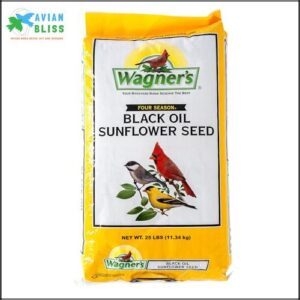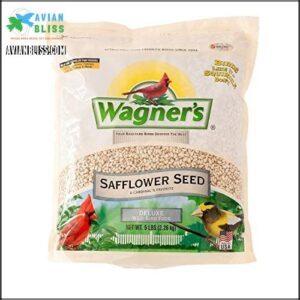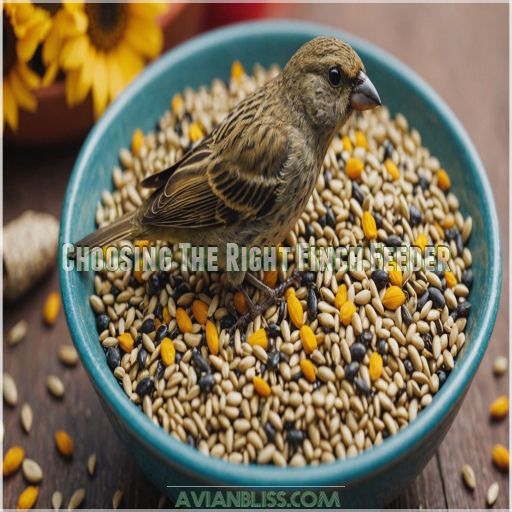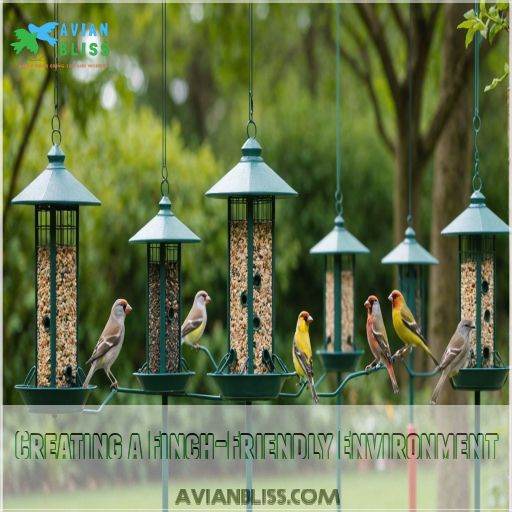This site is supported by our readers. We may earn a commission, at no cost to you, if you purchase through links.

Just note, it can be a bit messy, much like cleaning up after a party. For a change, try safflower seeds—finches enjoy them, while the pesky squirrels don’t.
Consider using a tube feeder to keep those seeds secure and entice finches to feast.
Ready for even more bird-friendly tips? We’ve got some surprises up our sleeves that’ll make your garden a finch paradise!
Table Of Contents
- Key Takeaways
- Top 4 Best Bird Seeds for Finches
- Choosing The Right Finch Feeder
- Creating a Finch-Friendly Environment
- Frequently Asked Questions (FAQs)
- Do finches eat sunflower seeds?
- What is the best bird seed for finches & sparrows?
- What can I feed a finch?
- What are the best bird seed mixes?
- What seed do finches like best?
- What is the best feed to attract finches?
- What do finches like to eat the most?
- What is the best food to attract goldfinches?
- How often should I refill finch feeders?
- What predators should I watch out for?
- Can finches eat other types of seeds?
- How to prevent mold in bird seed?
- Do finches prefer mixed seed blends?
- Conclusion
Key Takeaways
- You’ll find that Nyjer seed is a top choice for finches, offering high calories and attracting species like American Goldfinches and Pine Siskins. It’s the go-to seed for serious bird enthusiasts.
- Consider using safflower seeds if you’re tired of squirrels raiding your feeders. Finches love them, but squirrels generally don’t, keeping your feeders focused on bird visitors.
- Ensure that you use the right finch feeder type, like tube feeders, to accommodate small beaks and discourage larger birds. Cleaner feeders and fresh seed are key to ongoing attraction.
- To make your yard a finch-friendly haven, provide fresh water sources, plant native seed-bearing plants, and avoid pesticides to maintain a safe, appealing environment year-round.
Top 4 Best Bird Seeds for Finches
When you’re keen to attract finches to your yard, choosing the right bird seed is key.
Let’s explore some top options like Nyjer seed and safflower seed that finches just can’t resist.
1. Nyjer Seed Finch Food 10lb Bag

Choosing the Nyjer Seed Finch Food, packaged in a 10-pound bag, can help you attract finches like the American Goldfinch, Purple Finch, and Pine Siskin to your backyard.
This sterilized seed is a high-calorie favorite, ensuring no unwanted growth in your garden.
Some birds and squirrels may not be interested, which could be a plus.
You might need a specific feeder to manage the potential mess.
To keep the seed fresh, get smaller amounts if you’re a frequent user.
Best For: This Nyjer seed is best for attracting finches to your backyard, especially during the winter months.
- High calorie content keeps birds full and happy
- Sterilized to prevent sprouting
- Attracts various finches
- May attract unwanted pests
- Can be messy
- Some birds and squirrels may not be interested
2. Black Oil Sunflower Bird Food 25 Pound Bag

A 25-pound bag of Black Oil Sunflower Bird Food will have your finches flocking like bees to honey.
These seeds, with their thin shells, are a breeze for small-beaked birds to crack open.
Packed with energy, they support vibrant bird activity, attracting not just finches but also cardinals, chickadees, and more (Source).
Use tray feeders to entice these songbirds easily.
While some debris might mix with seeds, the variety and affordability more than compensate, making it a popular choice for bird enthusiasts (Source).
Best For: When choosing the right bird food, consider creating a bird-friendly balcony habitat by adding plants, flowers, and even a bird feeder on your balcony to attract a variety of birds. This bird food, which includes a balanced mix of essential nutrients like proteins, carbohydrates, and fats, is vital for avian nutrition, is best for bird lovers who want to attract a wide variety of birds to their feeders, and by incorporating a nutrient-rich healthy diet for pet birds, you can provide essential nutrients and prevent picky eating habits in the birds that visit your feeders. This bird food, which includes a balanced mix of essential nutrients like proteins, carbohydrates, and fats, is vital for avian nutrition, is best for bird lovers who want to attract a wide variety of birds to their feeders.
- High energy content to keep birds active and healthy
- Thin-shelled seeds that are easy for small-beaked birds to open
- Attracts a wide variety of birds, including cardinals, chickadees, finches, and more
- May contain some debris mixed in with the seeds
- Bag does not have a velcro closure
- May not be the best choice for those looking to attract only specific types of birds
3. Wagner Safflower Seed Wild Bird Food

Wagner Safflower Seed Wild Bird Food serves as a great option for attracting finches and other songbirds without inviting unwanted guests, as it’s a nutritious alternative to sunflower seeds for house sparrows.
Most squirrels wrinkle their noses at its bitter taste, keeping them at bay while your feathered friends feast.
This seed is particularly beloved by Cardinals and Chickadees, ensuring your backyard is filled with cheerful chirping.
Made from high-quality grains, it comes in a handy 5-pound bag, easy to keep your feeders stocked and your songbirds happy.
Best For: This is a great choice for bird lovers seeking to attract cardinals, chickadees, and other songbirds without feeding the squirrels.
- It’s a nutritious alternative to sunflower seeds, which are often favored by house sparrows.
- Squirrels generally dislike the bitter taste of safflower seeds, making it a great way to keep them away from your feeders.
- Made from high-quality grains, it’s a healthy and tasty option for your feathered friends.
- Safflower seeds can be more expensive than other types of birdseed.
- Some birds may not be as enthusiastic about safflower seeds as they are about sunflower seeds.
- It’s not as widely available as other types of birdseed.
4. Kaytee Safflower Seed 10 lb Bag

Kaytee Safflower Seed, in a convenient 10 lb bag, is loved by many bird species, especially finches.
Its unique appeal lies in being unpalatable to pesky squirrels, who often steer clear of these seeds.
Manufactured in China, this seed provides excellent training for bird enthusiasts keen to attract vibrant songbirds, as birds like the red robin, which has a more minimal song variation compared to cardinals, often visit backyards in search of food learn about red robin vs cardinal. this seed provides excellent training for bird enthusiasts keen to attract vibrant songbirds without unwanted visitors.
Although it can be messy due to its hulls, the seed’s benefits outweigh this drawback.
Just be prepared for a potential price increase and longer shipping times.
Best For: This seed is best for bird enthusiasts who want to attract a variety of songbirds without attracting squirrels.
- Loved by many bird species, especially finches.
- Squirrels are not a fan of this seed.
- Provides a great training tool for attracting birds.
- Can be messy due to hulls.
- Price has increased.
- Shipping is free but can be long.
Choosing The Right Finch Feeder
Choosing the right finch feeder is important for attracting these delightful songbirds to your yard.
From tube feeders with small perches to nyjer feeders and platform feeders, there’s a perfect option to cater to finches’ unique feeding preferences.
Tube Feeders With Small Perches and Ports
Bird seed choices matter, but let’s not forget the feeder itself.
Tube feeders with small perches and ports are perfect for finches.
The finch feeder size makes sure they can comfortably feed, while the precise perch spacing keeps larger birds at bay.
These feeders are easy to clean, and their strategic placement helps attract more visitors to enjoy the best finch seed.
Nyjer Feeders for Thistle Seed
Choosing the right Nyjer feeder is important for feeding finches like goldfinches and purple finches.
With a Nyjer feeder, you make sure:
- Nyjer feeder types are tube or sack feeders
- Thistle seed benefits help attract small songbirds
- Filling Nyjer feeders regularly prevents waste
- Cleaning Nyjer feeders keeps seeds fresh and appealing
Position feeders wisely to attract delightful visitors.
Platform Feeders for Ground-Feeding Finches
Finch enthusiasts often choose the best finch feeders Finch feeder options, which cater to the birds’ unique preferences. Nyjer feeders attract thistle-loving finches, but platform feeders offer a change of pace.
These feeders are ideal for ground-feeding birds like finches and sparrows, who enjoy seeds scattered on a stable surface.
When you place platform feeders strategically, you encourage ground feeders to visit.
Remember to keep them safely away from predators, and mix sparrow seed with other birdseed for variety.
Tips for Placing and Maintaining Finch Feeders
Your finch feeders need a perfect spot to thrive. Hang them 1.5 meters up and 3 meters from trees to deter predators.
- Consider squirrel-proofing for added protection.
- Choose feeder types like tube or sock feeders.
- Regularly check your cleaning schedule.
- Securely store the best birdseed.
- Create a diverse birdseed mix to attract more finches.
Creating a Finch-Friendly Environment
To create a finch-friendly environment, you’ll need to focus on providing fresh water, nutritious food, and safe surroundings for finches to thrive.
Finch-friendly plants should be considered and pesticides should be avoided to make sure these colorful songbirds feel at home all year round.
Providing Water Sources for Finches
Feeding finches properly is key, but don’t overlook water sources.
Shallow bird baths in safe spots, like stone or plastic, attract them.
Make sure water quality and depth are just right, around an inch deep.
Keep it fresh and clean.
Elevate the experience with this table:
| Bird Bath Type | Placement | Safety Tip |
|---|---|---|
| Stone | Ground or pedestal | Non-slippery |
| Plastic | Patio or garden | No sharp edges |
| Metal | Under shade | Prevent heating |
| Glass | Indoors in winter | Prevent cracks |
| Copper | Avoid direct sun | Check for tarnish |
Incorporate sparrow feeders, birdseed mixes, and wild bird food for a finch-friendly space.
Offering Fresh Fruits and Vegetables
Don’t forget to supplement your finch feeder with fresh fruits and veggies!
Sliced apples, grapes, and berries provide essential vitamins and minerals.
Chop up some melon, banana, or orange for a tasty treat.
Just be sure to remove any uneaten portions to prevent mold.
These natural offerings will keep your feathered friends happy and healthy.
Planting Finch-Friendly Plants and Trees
After offering fresh fruits and vegetables, consider planting finch-friendly trees and native plants.
These create a natural haven and supply year-round food.
Sunflowers, thistles, and coneflowers are top picks for attracting finches.
Seed-bearing plants and berry bushes delight their diet.
Incorporate a variety in your garden to complement any birdseed mixes and watch those feathered friends flock to your yard! .
Avoiding Pesticides and Creating a Safe Habitat
Creating a safe habitat for finches involves avoiding pesticides and embracing eco-friendly options.
This helps create a healthy, pesticide-free yard where they can thrive:
- Use natural pest control methods.
- Embrace organic gardening techniques.
- Opt for birdseed mixes free from harmful chemicals.
- Select bird feeder types that promote bird nutrition.
- Focus on bird care by maintaining a safe environment.
Tips for Attracting Finches to Your Yard Year-Round
To attract finches year-round, maintain clean feeders filled with their preferred seeds, such as high-oil thistle seeds for goldfinches learn more about when to put out finch feeders. focus on finch-friendly landscaping.
Place feeders with birdseed mixes, like sunflower and Nyjer seeds, strategically in your yard.
Make sure water sources, such as birdbaths, are available, even in winter.
Grow plants like sunflowers and coneflowers for natural food sources .
By mimicking their natural habitat, you’ll encourage finch behavior and attract sparrows.
Frequently Asked Questions (FAQs)
Do finches eat sunflower seeds?
Finches absolutely enjoy sunflower seeds.
They use their strong beaks to crack open the shells and savor the tasty kernel inside.
However, offer them in moderation, as sunflower seeds are high in fat and best as occasional treats.
What is the best bird seed for finches & sparrows?
Why not make your backyard a birding haven?
Finches and sparrows also enjoy chia seeds as a nutritious treat, packed with essential fatty acids, protein, and fiber from chia seed benefits for birds. Finches and sparrows love nyjer, millet, and sunflower seeds – just the right mix to attract these feathered friends.
Offer a variety and you’ll soon have a chirping chorus!
What can I feed a finch?
Feed your finch a balanced diet of seeds, fruits, and vegetables for the best health.
Include seeds like sunflower and thistle, with small amounts of broccoli, carrots, and zucchini, ensuring 75% seeds and 25% other foods.
What are the best bird seed mixes?
Bird seed mixes brimming with black oil sunflower, millet, and peanuts attract a vibrant variety of birds.
Premium blends that include nyjer and safflower for finches, and cracked corn and milo to delight sparrows.
What seed do finches like best?
Finches love Nyjer, also known as thistle seed.
It’s packed with fat and protein, making it a great energy source for these small birds.
Their tiny beaks are perfect for cracking open these small seeds.
What is the best feed to attract finches?
Think of attracting finches as hosting a party.
Use Nyjer and sunflower seeds, filling feeder socks or tubes.
These high-oil seeds cater to their small beaks, ensuring your backyard becomes a finch-friendly feast.
What do finches like to eat the most?
You might be wondering what finches love most.
It’s primarily seeds—think black oil sunflower and thistle seeds, among others.
Their diet also includes grains, fruits, vegetables, and occasionally insects, especially during breeding seasons.
What is the best food to attract goldfinches?
To attract goldfinches to your yard, offer them Nyjer seed, which they love.
Nyjer seed, a favorite of many Virginia small bird species, is often mistakenly called thistle, is perfect for finches and other small birds that ignore larger seeds.
How often should I refill finch feeders?
Refill finch feeders 2-3 times per week, checking daily.
Feeders should be kept clean.
Use fresh, high-quality thistle or black oil sunflower seeds to make sure your feathered friends have a steady supply of nutritious food.
What predators should I watch out for?
Predators like pesky domestic cats, cunning Cooper’s hawks, and sneaky snakes pose threats to finches.
Keep an eye out for raccoons, skunks, and chipmunks too, as these critters can catch your feathered friends off guard.
Can finches eat other types of seeds?
Finches can enjoy a variety of seeds, including black oil sunflower, thistle, canary, and millet.
Each type provides essential nutrients.
Offering a mix helps guarantee they’re getting a balanced diet, while catering to their preferences.
How to prevent mold in bird seed?
To prevent mold in bird seed, keep feeders dry by using weather domes or rain guards.
Make sure proper drainage is in place.
Store seeds in dry environments.
Regularly clean feeders with hot, soapy water if seeds become damp or moldy (Source).
Do finches prefer mixed seed blends?
When you offer a variety of seeds like nyjer, safflower, and canary, finches have options to choose based on their preferences.
Providing mixed seed blends can attract more finches to your feeders, enhancing diversity.
Conclusion
Finches favor nyjer seeds, so choosing the right type of seed is crucial for attracting them, as seen in the best nyjer seed blends for finches top rated bird seed mixes. Settling on the best bird seed for finches isn’t just about what’s popular; it’s about finding a formula that fits your feathered friends.
Whether you choose Nyjer, black oil sunflower, or safflower seeds, each option offers unique benefits.
Pair these seeds with the right feeder and create a welcoming environment with water sources and native plants.
By doing so, you’ll transform your garden into a finch-friendly paradise, ensuring these charming songbirds visit year-round.





